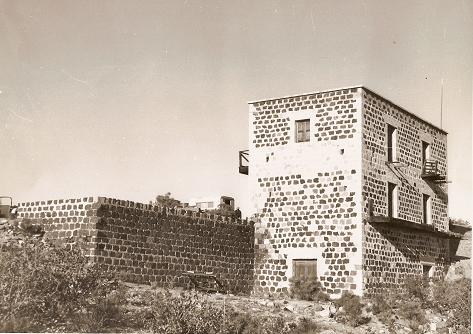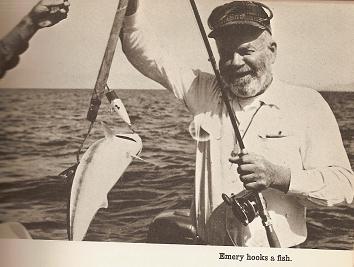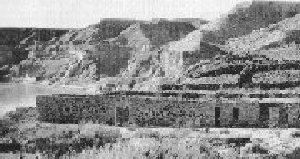| Pages:
1
2
3 |
David K
Honored Nomad
        
Posts: 65361
Registered: 8-30-2002
Location: San Diego County
Member Is Offline
Mood: Have Baja Fever
|
|
EL BARRIL MYSTERY by Choral Pepper
The following is a chapter from the late Choral Pepper's unpublished book, 'Baja's Missions, Mysteries and Myths'
THE MYSTERY OF THE OLD ROCK HOUSE
Purple clouds moved over the sun as we picked our way along the rutty road to El Barril. When a sturdy old building suddenly took form through the
mist, it appeared as spooky as an Addam's Family stage set. Weathered doors that once opened onto an encircling balcony were cracked, and the balcony
sagged, but the three stories of masonry had been executed with such precision that they seem destined for eternity. The sole occupant within those
empty walls is said to be a benevolent ghost, but the rock house of El Barril (not to be confused with El Barril on the Cape) arose long before the
ghost.
Standing high beside a protected port, it harbored both foreign and Mexican pearl smugglers around the turn of the last century when Baja's pearl beds
were being exploited for exportation. Hillocks of eroded, bleached shells that surround the house lay as testimony to those independent entrepreneurs
who took advantage of the rock house's secluded location to carry on their business in a tax-free atmosphere. But that wasn't the original purpose of
the house. The intent of the German gentleman who built it was not to provide housing for pearlers, although he did have the smuggling of another,
more astonishing commodity in mind.
In 1864, Mormons in the Utah territory were having trouble with the United States government. A military fracas seemed imminent. Expected freight
shipments that had to be carried thousands of miles across prairies and mountains from eastern markets often failed to arrive, but worse, so did newly
converted European immigrants called to their Zion in Salt Lake City. To alleviate this desperate situation, Brigham Young conceived of a novel plan.
He would establish a port on the Colorado River near the fringe of the Utah territory and transport his European saints directly into the arms of Zion
via the Gulf of California to the head of navigation on the Colorado River,
Anson Call was dispatched to do the job. In record time, Fort Callville, which today lies under Nevada's Lake Mead, arose on the banks of the
Colorado River about forty miles south of St. Thomas, a farming community on Utah's Muddy River also now inundated by Lake Mead. With the help of
fellow saints from the Muddy River mission, Brother Call constructed a massive rock-walled warehouse 120 feet long by 30 feet wide and a substantial
rock residence for himself, both similar in structure to the rock house at El Barril.
With his storerooms completed by February, Call received a discouraging blow. It would be at least three months before anything would arrive to store
in them. Steamboats made regular progress to mines and ore mills located along the lower Colorado River, but those at the upper end had to be
ring-winched through the treacherous Black Canyon rapids. During many months of the year, the water was too high and swift, or too low, to permit safe
navigation. Call learned that the best he could hope for would be three trips per month from July to November. This necessitated a plan for
safekeeping merchandise and converts brought up the Gulf on ocean-going vessels from distant ports until such time as they could be transferred aboard
a sternwheeler and transported up the Colorado to Fort Callville.
At first it was believed that gentiles (non-Mormons) at ports south would cooperate by holding goods until the upper waters became navigable, but less
than a month after the warehouse was ready for business, a steamboat captain commissioned by the Mormons to carry their freight to Fort Callville
encountered opposition. "The ports below seem to be jealous of the Mormon post," he complained to the editor of the Deseret News. The brethren were
forced to make an independent arrangement along the Gulf of California until such time as their converts and supplies could be transported north.
El Barril had been known since Spanish days as an emergency water stop for vessels. Its remote, but accessible, location on the Gulf lent itself
ideally to the Mormon's requirement for a place to conduct business in utmost secrecy. A German convert from the Muddy River mission, who had helped
in the construction of Fort Callville, was placed in charge. Soon the rock house rose on the beach above the luminous waters of the Gulf.
The rare Mexican vaquero who worked his way from the inland mission trail through forty-seven miles of wicked chaparral and nightmare masses of
granite to reach water at El Barril was content to believe the fancy quarters found there were built by a German trader who bartered ironwood for
goods from passing ships. Little did he know that further north such business was conducted by Indians who piled wood beside a rusty container into
which boat captains deposited chits redeemable at trading posts.
Records in Mormon archives of this endeavor are scant because the "Mormon Mission" of Baja was short lived. They made peace with Uncle Sam and the
completion of the Union Pacific Railroad promised safe delivery of freight at reasonable cost. In 1869 plans for shipping immigrants and freight to
Salt Lake City via the Colorado River were declared "unprofitable" by the Church. Both Fort Callville and El Barril were abandoned.
With time, the rock house at El Barril fared better than the old Mormon fort. Convert smugglers moved out; pearl smugglers moved in. The latter made
little use of the rock walls, finding them oppressive compared to their native mud-roofed huts with airy ocotillo walls, but water here was fresh and
in the shadeless desert it was pleasant to recline in the shadow of the old house while they shucked oyster shells.
Eventually, the rock house was sold to a mining syndicate that operated inland at Camalli and Los Arcos. During the mining heyday of the late 1880s,
its sturdy walls protected supplies arriving by boat, but when the mines ran out it reverted to its predestined purpose.
Prior to World War II, the Mexican government decreed it illegal to export live lobsters from Mexican waters to markets above the border. In
contrast, Uncle Sam welcomed Mexico's Western lobsters. This resulted in another busy smuggling industry. Flyers, called "bug pilots," cleared
primitive runways in remote spots along Baja's coasts where they landed on prearranged schedules to pick up lobster from native fishermen. Because the
shellfish had to be delivered alive above the border, time was of the essence. Planes flown by these men were decrepit and small. The air routes
they took to evade detection were unsafe. But wind or rain, bug pilots landed on death-defying terrain or took off into solid clouds, dependable as
the United States mail used to be. Later, during the war, these same flyers were in demand to instruct bush pilots, and after the war, many became
commercial pilots.
But during their exciting days of trafficking in the lobster industry, it was not unusual for a pilot to arrive on an evening prior to an
early-morning appointment with his suppliers. In that event, the old rock house gave convenient shelter near the primitive landing strip that today
delivers rich vacationers to elaborate new houses rising on the beach at El Barril or to gringo fishermen coming to the nearby resort at Bahia San
Francisquito.

[Edited on 1-31-2018 by David K]
|
|
|
Paulina
Ultra Nomad
    
Posts: 3812
Registered: 8-31-2002
Location: BCN
Member Is Offline
|
|
Thank you David!
\"Well behaved women rarely make history.\" Laurel Thatcher Ulrich
|
|
|
Barry A.
Select Nomad
      
Posts: 10007
Registered: 11-30-2003
Location: Redding, Northern CA
Member Is Offline
Mood: optimistic
|
|
Great info, David K.
Many thanks.
barry
|
|
|
David K
Honored Nomad
        
Posts: 65361
Registered: 8-30-2002
Location: San Diego County
Member Is Offline
Mood: Have Baja Fever
|
|
El gusto es mio!
I will eventually post all of Choral's chapters on Nomad, as I don't want to wait any longer for a publisher to come forward and I don't have the
energy right now to pursue publishing it myself.
They are all gold!
|
|
|
Osprey
Ultra Nomad
    
Posts: 3694
Registered: 5-23-2004
Location: Baja Ca. Sur
Member Is Offline
|
|
Thanks David, this is engaging and well crafted. More history from the U.S. side of things:
One sternwheeler left San Francisco, chugged all the way around Cabo San Lucas, up the SOC, then up the river to a popular landing place named
Nelson's Landing. There, loaded with goods bound for Callville, they were told by the notorious badlands bad guys around Nelson that Callville had
burned to the ground. The ship's captain believed the lie, sold the goods on the spot for ten cents on the dollar, motored back to S.F. Another
connection: the former owner of the Nelson museum was Merl Emery who acted as guide for Ray Cannon on one of his famous SOC journeys.
|
|
|
Barry A.
Select Nomad
      
Posts: 10007
Registered: 11-30-2003
Location: Redding, Northern CA
Member Is Offline
Mood: optimistic
|
|
"Merl Emory"----hmmmmmmmmm?????
------is that name also associated with Earle Stanley Gardner and his Baja excursions and books?
|
|
|
Barry A.
Select Nomad
      
Posts: 10007
Registered: 11-30-2003
Location: Redding, Northern CA
Member Is Offline
Mood: optimistic
|
|
-----and Osprey-----
Do you recall where on the river "Nelson's Landing" is, approximately?
barry
|
|
|
Osprey
Ultra Nomad
    
Posts: 3694
Registered: 5-23-2004
Location: Baja Ca. Sur
Member Is Offline
|
|
Barry, got my books mixed up. You are correct -- Earl Stanley Gardner and the famous Tote Goat. Nelson (and Nelson's landing), down a short paved
road just south of the dry lake bed as you leave Henderson, Nevada going south on Highway 95. It's the gateway to Lake Mojave which is just a wide
spot on the Colorado river before Davis Dam.
|
|
|
shari
Select Nomad
      
Posts: 13051
Registered: 3-10-2006
Location: bahia asuncion, baja sur
Member Is Offline
Mood: there is no reality except the one contained within us "Herman Hesse"
|
|
Cool, I always wondered what that stone building was! It was so out of place there and intriguing. gracias amigo
|
|
|
DENNIS
Platinum Nomad
       
Posts: 29510
Registered: 9-2-2006
Location: Punta Banda
Member Is Offline
|
|
| Quote: | Originally posted by Osprey
You are correct -- Earl Stanley Gardner and the famous Tote Goat. |
Didn't he have the Baja Burro as well?
|
|
|
Barry A.
Select Nomad
      
Posts: 10007
Registered: 11-30-2003
Location: Redding, Northern CA
Member Is Offline
Mood: optimistic
|
|
Yes, and the "butterfly", I think it was called. May be more inventions, too. He was/is (?) a remarkable engineer who lived/lives (?) in Paradise,
CA above Chico, as I recall.
I think his name was spelled "Murl".
|
|
|
Barry A.
Select Nomad
      
Posts: 10007
Registered: 11-30-2003
Location: Redding, Northern CA
Member Is Offline
Mood: optimistic
|
|
I did some research--------the guy we are calling "Merl Emory" is actually Murl Emory. He grew up on the Colorado River, and was a prospector, and
ran boating concessions on the Lake Mead and the river. He was a good friend of Earle Stanley Gardner and went with him on several of the Baja
adventures that ES Gardner writes about. There is much about Murl in Gardner's book, "HOVERING OVER BAJA", as well as "HUNTING THE DESERT WHALE".
The guy that lives in Paradise is J.W. BLACK. He is the one that invented the "Pak Jak", "Burro", "Burrito", and the aforementioned, "Butterfly", as
well as other "desert" vehicles.
barry
|
|
|
DENNIS
Platinum Nomad
       
Posts: 29510
Registered: 9-2-2006
Location: Punta Banda
Member Is Offline
|
|
I think Gardners Baja books are out of print. I used to have all of them and I'm going to hit the San Diego used book stores and get them again. I
know of one store that has EVERYTHING. I once aked if they had a first edition of God and Mr. Gomez and his reply was, signed or unsigned? He had
more than one of both.
|
|
|
Paulina
Ultra Nomad
    
Posts: 3812
Registered: 8-31-2002
Location: BCN
Member Is Offline
|
|
Dennis,
FYI
Bernie turned me onto a great online source for baja books. I recently picked up a hardback first edition copy of God and Mr. Gomez for $5.00
www.abebooks.com
P<*)))><
\"Well behaved women rarely make history.\" Laurel Thatcher Ulrich
|
|
|
John M
Super Nomad
   
Posts: 1924
Registered: 9-3-2003
Location: California High Desert
Member Is Offline
|
|
Murl Emery
I also have some interesting reseach regarding Emery - and I do think it is Emery and not Emory - at least that is the way Murl spelled it on some
documents he wrote.
I have asked permission to post a couple of Emery photos - mostly related to his Nevada activities. There is a chapter about Murl & Nelson, Nevada
in the book "Eldorado Canyon and Nelson, Nevada" compiled by Donna Andress.
In the event anyone (Barry A.?) is interested I have Mrs. Andress's email and she still has some copies of her book.
John M
|
|
|
DENNIS
Platinum Nomad
       
Posts: 29510
Registered: 9-2-2006
Location: Punta Banda
Member Is Offline
|
|
Thanks P<*)))>< ....
I've bought from them in the past as a used book source through Barnes and Noble but, it never occured to me to search their inventory. I will.
|
|
|
David K
Honored Nomad
        
Posts: 65361
Registered: 8-30-2002
Location: San Diego County
Member Is Offline
Mood: Have Baja Fever
|
|
Murl Emery

|
|
|
David K
Honored Nomad
        
Posts: 65361
Registered: 8-30-2002
Location: San Diego County
Member Is Offline
Mood: Have Baja Fever
|
|
These two pictures from Erle Stanley Gardner's 'Hunting the Desert Whale' c1960

|
|
|
John M
Super Nomad
   
Posts: 1924
Registered: 9-3-2003
Location: California High Desert
Member Is Offline
|
|
Fort Call
Below is a photo of the rock structure David referred to in the opening post of this thread.
Choral Pepper called it Fort Call. Stanley W. Paher, in his book Callville Head of Navigation Arizona Territory wrote “Many referred to it as ‘Fort
Call,’ probably because of the massive warehouse walls.”
Additionally there was a detachment of military – Companies D and then K - Fourteenth Infantry - there for a time, early February 1867 until May of
1868. (Casebier Camp El Dorado, Arizona Territory), perhaps this also contributed to the Fort Call idea.
The photograph of the stone structure pictured here was taken in the 1930s just before being flooded by Lake Mead. (photo from: Steamboats on the
Colorado River by Richard E. Lingenfelter).
The establishment there was more commonly referred to as Callville.
John M.
[Edited on 11-26-2007 by John M]

|
|
|
Hook
Elite Nomad
     
Posts: 9011
Registered: 3-13-2004
Location: Sonora
Member Is Offline
Mood: Inquisitive
|
|
Thank you for the original story, David. I found it very interesting.
So, is it still standing? Is this the El Barril south of San Francisquito?
|
|
|
| Pages:
1
2
3 |

